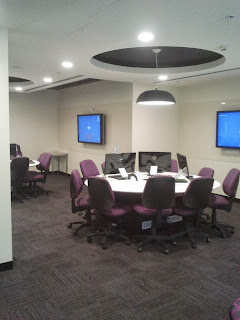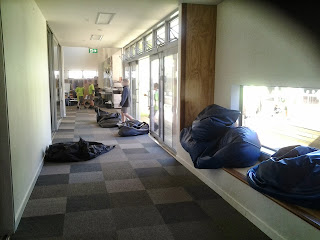Last Tuesday I had the fortune to visit
Northern Beaches Christian School I was interested in the
Sydney Centre for Innovative Learning. I discovered this school through Google when searching for 'innovative schools' and a quick exchange of emails and booking of flights had me on my way to Sydney.
There are several things that stood out to me when participating in a
Snapshot tour. The first being that not only were educators in the tour but also an architecture/design company who have worked with several school but had heard about SCIL. About 18 people participated in the tour with an almost even split of primary and secondary school educators.
The first thing that Micheal will tell you, before you see anything. Is that they don't have a neat package that you can take away with you to implement but what they are willing to do, is share with you everything they have done. This journey for NBCS has been 7 years and started with an idea/vision and is constantly developing and evolving. Whilst initially they had ideas they now use the design model:

The school vision is: Exceed all expectations, with the Misson: Excellence in Education and Christianity in Action. Staff are encourage to think innovatively, the senior manager are open to ideas and are willing to trial what the teachers want to do. Having said that they do not mandate anything, each department and staff member can move in this direction as quickly or slowly as they are able. New staff are hired through an interesting process where students, and staff are actively involved. Staff and all applicants sit down for a discussion together, candidates teach a lesson and students are asked for feedback. Staff at the school are often team teaching, taking responsibility for different aspects of the program and teaching together in large spaces. Classroom numbers have disappered with rooms being named e.g. the arts area had rooms known by different gallereys. Often the middle wall between 2 classes had been removed providing a larger space. The library had been moved and the old building now houses all Year 6 and 7 - it is a massive space on several different levels.
The school has BYOD program (any devices is accepted) and it was great to walk around the school and see technology as a tool for learning. Moodle is the LMS, images with hyperlinks are used on the department pages instead of the scroll of death. It was interesting to talk with one student and ask if all her subjects were structured the same. Her reply was 'No' she enjoyed the structure within English but also enjoyed the strong inquiry focus with Music; what was key was variety. One of the problems the school has overcome through this change is a huge decrease in apathy from the senior students. Students have more control, choice and are working in a positive environment where learning has moved from the industrial era to something innovative, practical and current but still evolving.
Furniture, what did I see? I saw furniture that could be moved around easily and used in different ways. Surfaces, such as windows, walls, desks even doors for students to create ideas on. Seating that could easily be moved to create small or large groups that were comfy. Of course desks, of different shapes and sizes again some mobile and some not. It was also interesting to see the large open spaces and spaces where students of a variety of year levels were working in the same area.
A photo of one space - a picture gallery will go up on the right side of the blog
I think what struck me, was my thinking was on track. That classroom design should go hand in hand with pedagogy. What ultimately are we wanting students to walk away with and how do we get there? We need to back to the design model and remember to ask all involved. It is not enough to go BYOD - instead how is learning and teaching going to change. Learning is a journey and at no point did anyone on the tour mention an end point, when the school would be 'finished'.
The
website is well worth a look at and the
research papers are short and manageable. This school is well worth the visit and the staff are helpful approachable and willing to share their experiences.
On the left of the blog is a video tour of the SCIL building with information from Stephen Harris





















